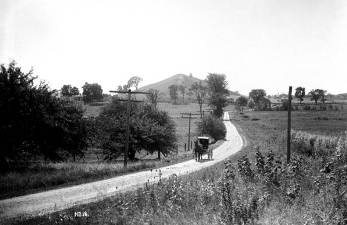New York Period
- Return to general Mormon history article.
Contents
New York/Pennsylvania Period
The real history of the Mormon Church at this period is the story of Joseph Smith and his family (see Lucy Mack Smith), and begins long before the Church was formally organized. Most historians date this period of Church history between 1820 and 1830, shortly after the formal organization of the Church. The period includes many significant and formative events not only for the Church, but also in Joseph Smith's life.
Angelic Visitations
On September 21, 1823, about three and a half years after his First Vision[1], Joseph Smith was led again to pray for forgiveness of his sins, and to know his standing before God. Although he reported that his previous experience had led him to confidently expect an answer, even a miraculous manifestation, the content of that answer astonished him. He was visited that night by an angel who announced himself as Moroni[2], and told Joseph of the existence of a record engraved on golden plates. The angel told Joseph that it would be his responsibility to obtain these plates, which were buried in a hillside (later called "Hill Cumorah") near his home, and translate the contents. The angel quoted a number of prophecies from the Holy Bible, saying that they were about to be fulfilled, and gave Joseph additional instructions.
The angel returned twice more that night and repeated the instructions he had given, and again the next day. Joseph went to the place the angel had indicated and attempted to recover the plates, but the angel appeared and told him that the time was not yet right. He instructed Joseph to return to that spot yearly on that date (September 22) for further instructions. This Joseph did, and was permitted to recover the plates on his final visit in 1827.
Digging for Money
In the intervening period, a number of significant events had happened in Joseph's life. His admired elder brother, Alvin, died just two months after Moroni's first visit. Despite this loss, his family, through much hard work, had begun to prosper. Rumors of Joseph's visions had begun to spread through the surrounding countryside, with the result that Joseph was persecuted and harassed as well as being sought after for his presumed supernatural talents. Perhaps for this reason, in 1825 he was employed by Josiah Stowell, a wealthy resident of South Bainbridge in Chenango County, New York, to help him locate a Spanish silver mine believed to be somewhere in the vicinity.
Although this enterprise was unsuccessful, it bore fruit in another way. While employed by Stowell, Joseph and his father boarded at the home of Isaac Hale. There Joseph met Hale's daughter, Emma, and subsequently married her. He also had his first taste of official persecution when one of Stowell's relations, evidently jealous of Joseph's friendship with Stowell, contrived to get him arrested on trumped-up charges. He was brought before a local magistrate and discharged without trial. Rumors about this event, which by all solid evidence constitutes Joseph's only involvement with the "money-digging" industry, have been parlayed by some detractors into a long-running money-digging career and a criminal conviction, neither of which can be sustained by the evidence.
Translating the Book of Mormon and Establishing the Church
By the Autumn of 1827 Joseph was 21 years old, then the age of legal majority, and married. After Joseph obtained the plates, he moved to Harmony, Pennsylvania, and began to try to translate the plates. Ultimately he was able to do this, with the help of his wife Emma, Martin Harris, and especially Oliver Cowdery, a local school teacher, who acted as scribes while Joseph translated. In March of 1830, the translated work was published as the Book of Mormon[3]. Joseph's own account of these events is found in the scriptures of the Church.
Shortly after the Book of Mormon was published, Joseph received a divine commandment to organize the Church. This organization occurred on April 6, 1830, in the home of Joseph Knight, in Fayette, New York. (Some historians believe it was in Palmyra, but the evidence in support of this location is slender, and the place a relatively unimportant detail anyway.)
Immediately after the Church was founded, missionaries began preaching. The first missionary was Joseph's own brother, Samuel H. Smith. These missionaries converted many in the areas around Fayette, Colesville, and Manchester, New York. Missionaries were sent in all directions. One group in the summer of 1830 went west to preach to the Native American Indians. Along the way they taught and converted many around Kirtland, Ohio. The Church grew quite rapidly and attracted much attention in the local press. Though much of the press was negative, the new Church, then called the Church of Christ, grew rapidly in New York.
- Proceed to next time period.
